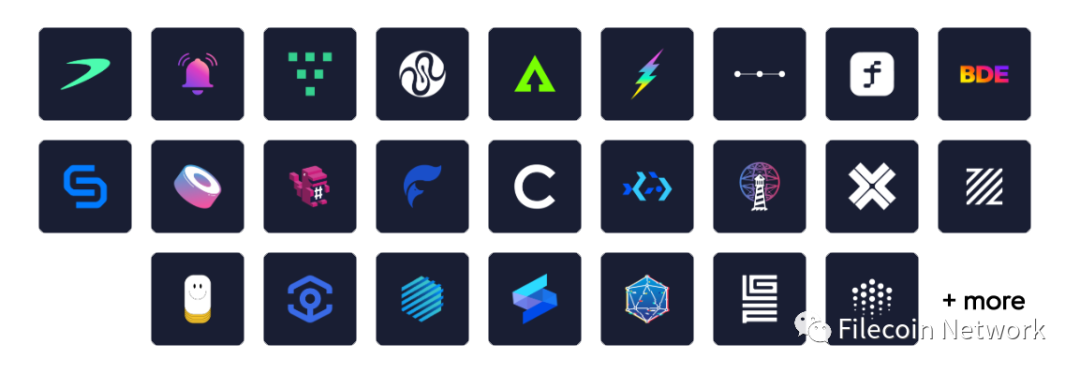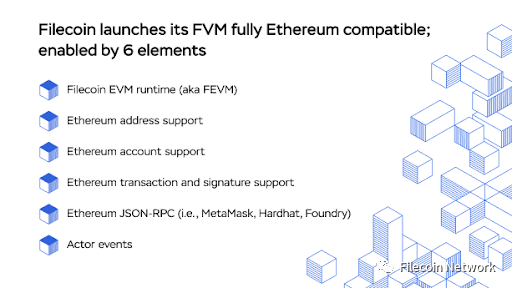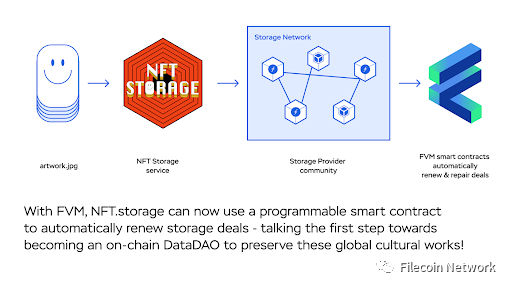
Today, the Filecoin community is pleased to announce,Filecoin Virtual Machine (FVM) started successfully(http://fvm.dev/). Starting from epoch 2, 683, 348 (3:14 PM UTC, March 14th), the Filecoin blockchain has been enabled via FVMSupport for smart contracts and user programmability.This will unlock the enormous potential of the open data economy.
This is a memorable page on Filecoin's expansive roadmap. The vision of Filecoin is to bring open, publicly verifiable features to the three core pillars supporting the data economy(storage, computing, content distribution). With FVM, developers can deploy smart contracts and plan how data is stored, governed, and monetized in the open market. When phones started to become "smart," the ability to write and run apps made devices far more useful than factory-installed software. The space for freedom and innovation allowed the smartphone to start taking over the world. Similarly, with FVM, developers can deploy smart contracts and plan how data is stored, governed, and monetized in the open market.
The release of FVM also startedFilecoin main plan(https://filecoin.io/blog/posts/the-filecoin-masterplan/) The last link. The plan aims to bring the ability of large-scale data computing and empowering network-level applications to the world's largest decentralized storage network.
secondary title

Unlocking the Open Data Economy for Web3
Not only does the FVM virtual machine bring us one step closer to a robust and usable decentralized cloud service, it also allows us to enable thousands of developers, storage providers, entrepreneurs and other network participants around the world to have The data economy and rewarding individuals for their contributions. For example, Waterlily (https://www.waterlily.ai/), an AI tool that generates images of a specific artistic style based on prompts, will use tokens to directly reward creators of original AI training data.
Not only does the FVM virtual machine bring us one step closer to a robust and available distributed cloud service, it also allows us to put data ownership by thousands of developers, storage providers, entrepreneurs and other network participants around the world in ways never before possible economy, and rewarding individuals for their contributions. For example, Waterlily, an AI tool that generates images in a specific artistic style based on prompts, will use tokens to directly reward creators of original AI training data.
In the past few months, after experimenting, iterating and strengthening the program on the Filecoin test network, more than 150 development teams have begun to deploy FVM products and services on the Filecoin main network, and Waterlily is one of them. The ability to deploy things like FVM-based DataDAOs and dApps, some of which were previously difficult to build, has inspired more than 16,000 developers in the Filecoin ecosystem.
FVM also brings the Web3 world closer to the Filecoin ecosystem: the first runtime (Runtime) launched on FVM is the well-known EVM virtual machine. Although other virtual machine runtimes will be launched on FVM as time goes by, the first choice of EVM is to pay tribute to the friends in the Ethereum ecosystem and the powerful developer tool community and thriving tool ecosystem built by them. The entire Filecoin community welcomes the upcoming FVM integrations from projects such as Ankr, Axelar, Brave, Celer, Ocean, Sushi, and Tellor.
“We are excited to integrate FVM and leverage its powerful smart contract capabilities to enhance Sushiswap. Through FVM, we can unlock the frontiers of distributed finance and provide users with more innovative and efficient solutions. We are happy to continue to work with the Filecoin team Collaborate to build the future of DeFi." - Jared Gray, Sushi CEO

The products and services that FVM can develop represent new growth and value capture avenues to capitalize on existing, emerging or entirely new market opportunities worth trillions of dollars. Ultimately, FVM and the Filecoin network can support the development of a range of applications, markets, and organizations that will dwarf existing centralized cloud service providers and their users in depth and breadth. Investors are excited about this potential, and have planned to arrange millions of dollars in funding to help businesses in the Filecoin ecosystem that want to take advantage of these market opportunities. For example, Longhash (https://www.longhash.vc/accelerator/filecoin-accelerator/) and Graph Paper Capital (https://graphpapercapital.notion.site/Graph-Paper-Capital-Network-2b 1816 2d 2 ec 94498 bbac 4 b 53 bb 308 a 28 ) has launched an accelerator program focused on FVM.
FVM also hopes to unlock more opportunities for the network's storage providers, who have provided more than 13 EiB of storage capacity to the network, making Filecoin the world's largest public storage network. After launching from the mainnet, the storage provider has stored more than hundreds of TiB of customer data, locked 130 million FIL as collateral, and continued to earn block rewards and income from storage transaction proposals. From the start of FVM, the distributed financial services built by developers will make it easier for FIL, an important part of the Filecoin storage network, to lend to storage providers to help improve storage capacity and usage. In general, third-party developers (such as Glif (https://glif.io/), FILL Pool (https://fillpool.space/), Filet Finance (https://www.filet.finance/) etc.) are planning to provide more than 5 million FIL to storage providers who will participate in the Pilot project in the next few months through the DeFI service.

FVM enables third-party DeFi solutions, such as FIL lending for storage providers, to fuel growth and increase the capacity and availability of the Filecoin storage network
Participants such as the key players of Web3 are using the Filecoin virtual machine for lending, permanent storage, cross-chain, verification and other functions.
FVM is revolutionizing the way we interact with the web3 ecosystem, inspiring partnerships with noteworthy web3 projects: from FVM-based lending services, to persistent storage solutions, developer tools, DeFi and cross-chain solutions, and more. Let's go ahead and dig deeper.
DeFi Lending Protocol
FVM allows developers to build new types of applications to help storage providers obtain FIL for collateral. Specifically, FIL token holders will soon be able to invest their own FIL to help storage providers operate through smart contract-based protocols. These protocols will have their own set of criteria to select storage provider objects that need to borrow FIL, and use different methods to set the loan terms and requirements. Allowing Filecoin token holders to connect with storage providers more efficiently can accelerate data growth on the network and allow new storage providers to bring their services to the network more efficiently.
Persistent Storage and Data DAO
Prior to the launch of FVM, storage transaction proposals were not perpetual and had to be renewed every 1.5 years. Now, FVM enables users to store only once and let repair and replication bots manage the repetitive storage transaction proposal creation tasks. Using smart contracts, users can plan wallets with FIL funds to fund permanent data storage, and can choose services between different storage providers over time. This gives users the ability to have long-term storage (some blockchains claim they do), while benefiting from Filecoin's Verifiable Proof of Storage (https://filecoin.io/proof-of-replication.pdf) mechanism, ensuring that The network properly stores and replicates its own data.
Data DAOs can also take advantage of persistent storage. By using an FVM actor contract to coordinate and manage data uploaded to the DAO, they can ensure certain standards are met to maintain a scalable and clean dataset. The FVM actor contract can also be used to mint tokenshe NFTs to be distributed to members participating in the DAO, incentivizing their actions. Combining persistent storage and Data DAOs offers unlimited creative potential for distributed data management, payments, and governance. Ocean, NFT.Storage, and Waterlily are just a few examples of those that are using FVM to transform community-governed storage use cases.

Through FVM, NFT.storage can use programmable smart contracts to automatically renew storage transactions-the first step towards becoming a DAO that preserves data on the global cultural industry chain!
Cross-chain solution
The Filecoin virtual machine can be integrated with leading web3 blockchains to achieve cross-chain communication (Polygon and Ethereum, etc.) and cross-chain liquidity (Celer, Axelar, etc.). This will add powerful data capabilities to various blockchains. For example, dapp users of other chains can access and pay for Filecoin services (such as verifiable storage and distributed computing through smart contract calls, as well as implementing existing liquidity in the form of wrapped tokens.
"The integration of Axelar-Filecoin is the first use case where different property chains are combined through interoperability. For example, DeFi of different blockchains will be able to be combined with distributed storage, no matter what services they want to build." - Sergey Gorbunov, Co-Founder, Axelar
FVM will support distributed finance and can provide services for the value flow of FIL, other tokens and legal tender on and off the chain. Through FVM, there will be some new ways to trade through wallets such as Metamask and Glif, and mainstream trading platforms (such as Binance, Coinbase, and Kraken, etc. will also have corresponding support. You can exchange other assets on the chain in a native way (Including bridging versions of ETH, BTC and other stablecoins to achieve native asset management strategies on the chain. Users can use cross-chain decentralized exchanges (such as Squid), a series of automatic market-making mechanisms (such as SushiSwaphe and FilSwap) and derivatives products (such as Thetanauts) to find the lowest fee path and develop insurance and hedging strategies. Realize native asset management strategies.
DeSci, video, games and more
The combination of smart contracts with content addressing and verifiably persistent storage opens up limitless opportunities for distributed data management, payments and governance. The launch of FVM unlocks new paradigms for FVM-based video authoring, streaming storage (like Livepeer), social data preservation and portability, real-time gaming, and more.
"We're excited to provide even more ways to build and access a distributed internet by using FVM on top of Brave's support for Filecoin and IPFS." - Brian Bondy, Brave co-founder and CTO
This is just the beginning. Web3 entrepreneurs now have the opportunity to unlock the potential of the trillion-dollar open data economy and reimagine Web2 business models. Startups in Filecoin and adjacent ecosystems have raised more than $200 million, and the Filecoin community has provided a lot of support and funding programs for these teams-this includes the newly launched web3 accelerator program and the upcoming bug bounty program (for Bai Hat hackers are offering rewards of up to $500,000, details to be announced soon).
secondary title
After the launch of FVM, the next step of the Filecoin community
The Filecoin ecosystem is excited to celebrate this important milestone with the entire community. We are grateful to those who have contributed time and effort to this open source technology over the past few months.
"FVM is a major step forward for blockchain and Web3, enabling developers to create new types of applications and bring the enormous potential of smart contracts to large-scale data" - Juan Benet, Founder, Protocol Labs
text
text
text
text
text
Twitter: @Filecoin
text
GitHub: https://github.com/filecoin-project
text
text
texthttps://github.com/filecoin-project
text
Storage on mainnet: https://docs.filecoin.io/



